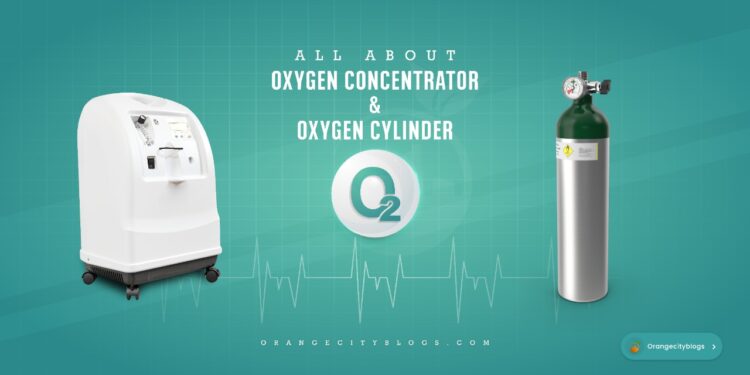- Written By: Mr. Ajai Nigam (Rtd. Chief Controller of Explosives (PESO))
Oxygen Concentrator and Oxygen Cylinder
Oxygen therapy has emerged as the primary treatment for critical patients infected during the second Covid-19 wave in the country. Presently India battles a massive spike of covid-19 cases and the existing health infrastructure being inadequate with respect to availability of hospital beds, oxygen/ ventilators and trained health warriors and therefore people are forced to look for alternatives. Even authorities are also advising patients to go for Home isolation where oxygen support is also considered necessary in form of Oxygen cylinder or concentrator.
Thus, the demand for oxygen concentrators/cylinders is rising for patients being treated at home. Now question comes, which device is to be preferred. While both Concentrator or cylinder serve the purpose of supplying oxygen to treating patients at home, but the following details on both will help you in taking the decision in this regard:
An oxygen concentrator collects oxygen and nitrogen present in the surrounding air and filters the air that it provides to the patient via nasal cannula or oxygen masks. Oxygen concentrators are capable of producing up to 95% of pure oxygen. Since they have in-built oxygen sensors, it can be clearly seen if the purity level reduces in the concentrator. However, with so many models of oxygen concentrators in the market, many are finding it difficult to choose the right one with an ideal price. Here we strive to give you the required information which will help you make an informed decision.
Difference between Oxygen cylinder and Oxygen concentrator
Oxygen Cylinders and Oxygen Concentrators both deliver oxygen to patients who need it. But the methods of delivery are very different. In India, Oxygen Cylinders are more prevalent, but increasingly Oxygen Concentrators are becoming popular with both doctors & patients. In case of Cylinders, one has to ensure that such cylinder and valve fitted thereto is of a type and standards specified in Gas Cylinder Rules, 2016 i.e. genuinity is to be checked before hand in the interest of safety, otherwise no filling plant will accept such cylinders for filling when it gets empty due to usage by treating patient at home.Besides, filling and storage of cylinders is to be in conformity of said law.
The main difference between the two is in the way the oxygen isprovided. Oxygen Cylinders have a finite amount of oxygen compressed within them and inhaled by the user until it runs out. Whereas Oxygen Concentrators filter and generate medical grade oxygen, at an infinite supply so long as the battery that powers this mechanism has life. An oxygen concentrator works like an air conditioning machine: it takes in air, modifies it and delivers it in a new form.
The only difference is that a concentrator purifies the air and makes it available for patients who have low oxygen levels in their blood. Cylinders accomplish the same but all the oxygen is already compressed within it. That supply is gradually reduced until it runs out and needs to be refilled or replaced. Here again issues of handling of cylinder and running for its filling at plant with statutory documents are involved. Besides, there is difference in the dosage methods used by each type of device. All oxygen cylinders deliver oxygen on Continuous Flow. With oxygen concentrators, it tends to vary by device, as some of the more portable options operate on pulse-dose delivery.
What are the benefits of an Oxygen Concentrator?
Oxygen concentrators offer several advantages over oxygen cylinders, such as:
1.Consistency – Whereas oxygen cylinders can run out of oxygen, an oxygen concentrator will never run out of oxygen as long as it has air available and a supply of power. An oxygen concentrator extracts oxygen from the air itself, making the supply unlimited and readily available.
2.Safety – An oxygen cylinder could begin to leak, and oxygen-saturated air increases the risk of a fire. If a fire ignites under these circumstances, it is harder to extinguish because oxygen-induced fires burn hotter than many other kinds of fires. Pulse-dose oxygen concentrators simply create oxygen as needed, eliminating the concern of leaks, and therefore the concern of flammability.
3. Size – An oxygen concentrator is designed for convenience and portability – so it weighs much less. On the contrary, Oxygen Cylinders are
bulky, heavy and involve inconvenient handling and require Trolley for safe movement in home.
4. Cost – is another factor to consider. For Oxygen Concentrators, the price is largely upfront. For Oxygen Cylinders, costs will be incurred over time – e.g. new Oxygen Cylinders purchased periodically as needed. However, innovative companies like Tribeca Care dia are making Concentrators more affordable by making them available on long-term rentals.
Keep in Mind
1. Due to the sudden surge in the demand for oxygen concentrators, their availability has become an issue both online and offline. Still, some websites like 1mg, Nightingales India, Healthline, and Healthgenie, are selling oxygen concentrators but buyers need to be careful as some lesser-known websites are also selling equipment like nebulizers and humidifiers and scamming people by charging for the price of an oxygen concentrator.
2. Users should ensure that they are having the oxygen concentrator of a trustworthy brand, like Equinox, Ox life, Inogen, Aspen, OCM, and Yuwell.
3. If you have confirmed that you are buying an authenticated oxygen concentrator, the next step is to check its flow rate capability. Flow rate is the rate at which the oxygen can travel from the machine to the patient. Every patient requires different flow rates, thus it is recommended that you discuss this with your doctor and then proceed.
4. Every oxygen concentrator draws a different amount of power. The one with the lowest power consumption doesn’t have to have the same flow rate as prescribed by your doctor. A lot of times the prescribed concentrator will draw more power. But keep an eye out on the models which have an option of working on consumer-grade batteries so that the machine keeps working even if the power goes out.
5.Users also need to check the level of oxygen concentration provided by the machine they buy. The filtered oxygen that reached the patient has a particular percentage of pure oxygen which is called oxygen concentration. While a lot of oxygen concentrators have a concentration value between 87%-99%, this value can also differ between the models. Mostly, portable oxygen concentrators do not provide higher oxygen concentration.
An Oxygen Concentrator is a great choice for all the above reasons. But individuals should also consider having a backup Oxygen Cylinder as well as additional, fully charged batteries for the Oxygen Concentrator in case of a power outage.
Do I want to rely on battery life or oxygen supply? What size device am I looking for? Do I want a bulky cylinder in the house or an easy-to-move concentrator? These are all questions that a Tribeca Care expert can help you with. In the end, it’s about deciding what offers the best choice for your lifestyle.
Written By: Mr. Ajai Nigam (Rtd. Chief Controller of Explosives (PESO))














Very well explained, a great guide if you are considering buying oxygen generating device.
Informative & practical suggestions- a must read for patients & well wishers.
Problem in a country like ours is cost, duplication, & feasibility of use & maintenance in a rural setting.